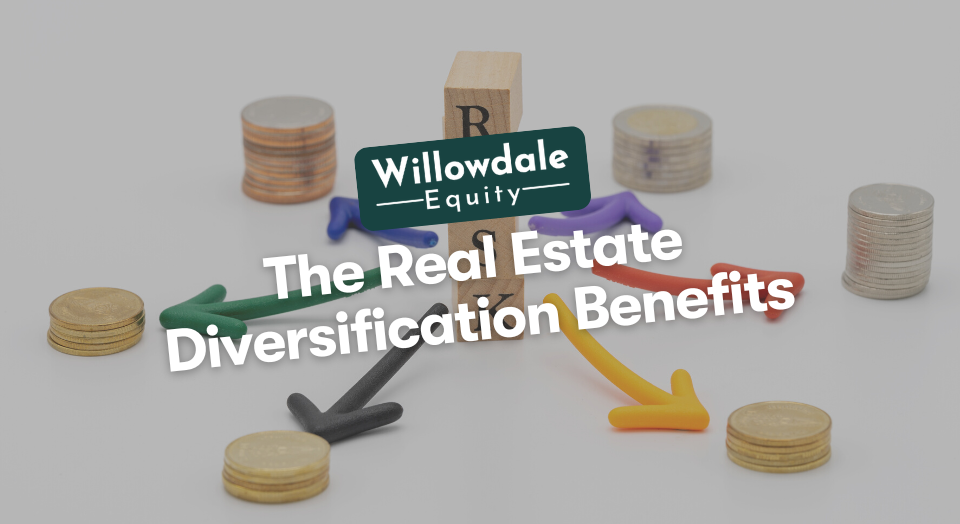
Diversify Real Estate: How Real Estate Diversification Benefits You
When it comes to real estate investing, there are a lot of different options to choose from. You can invest in commercial real estate, residential real estate, or even land. One of the most popular options to diversify real estate and your portfolio is by investing in multi-unit rental properties. Why is this such a smart move? Because it allows you to take advantage of different market conditions and spreads your risk among several types of investments.
This blog post will discuss the benefits of real estate diversification and how changes to your real estate investment strategy might help you reach your investment goals sooner.
Key Takeaways
-
Investing in different geographical real estate locations makes you less likely to lose all of your money if one particular market takes a nose-dive.
-
One of the best ways to reap the benefits of diversification in your real estate portfolio is by investing in multiple units at one time. This could mean buying an 8-unit, 25-unit, or even a 100-unit property.
-
While real estate diversification can offer much protection for your investment portfolio, there is such a thing as too much diversification. This is because as you diversify your portfolio, you also spread your risk. This means that you are more likely to lose money on at least one of your investments which can impact the overall performance of your portfolio.
How Real Estate Diversification Protects Your Investments
One of the most significant benefits of diversifying your real estate portfolio is protecting your investments from market fluctuations. For example, let’s say you invest your money into residential real estate. If the residential real estate market takes a hit, your entire investment portfolio will suffer.
However, if you have diversified your portfolio by investing in both commercial real estate and residential real estate, then you will be protected from taking such a significant loss. This is because the two markets often move independently, so if one goes down, the other may not necessarily follow suit. By diversifying your real estate portfolio, you are essentially hedging your bets and giving yourself a better chance of weathering any market downturns that might come your way.
Advantages of Real Estate Investment in Multiple Markets
Another way diversifying your real estate portfolio can protect your investments is by spreading your risk. Investing in different geographical real estate locations makes you less likely to lose all of your money if one particular market takes a nose-dive. This is because the other markets you have invested in may not be affected by the same problems.
For example, suppose the real estate market in your city suffers a downturn due to a recession or a natural disaster. In that case, your real estate portfolio consisting of investments in other markets that you have invested in may not be impacted as severely.
Diversification Benefits From Real Estate With Multiple Units
One of the best ways to reap the benefits of diversification in your real estate portfolio is by investing in multiple units at one time. This could mean buying an 8-unit, 25-unit, or even a 100-unit property. Even if you have some vacant units or a few bad tenants, your property’s performance can still be strong. The most This is not the case with single-family homes.
By owning a multi-unit rental property with multiple income streams, your property’s net cash flow is much more consistent and equates to a more stable investment. This is one of the many reasons the most sophisticated real estate investors invest in large apartment complexes over single-family homes.
Other Investing Real Estate Diversification Benefits of Apartments

Investing in apartment buildings provides you with a steady stream of reliable passive income and allows you to take advantage of economies of scale. This means that the more units you own, the lower your overall costs. For example, if you own a 100-unit property, you can negotiate better deals with vendors and get discounts on insurance and repairs.
Also, most people that invest in real estate plan on hiring property managers when building their real estate portfolio. Since most property managers earn a percentage of the gross income that the rental property they’re managing produces, rental properties with a higher income potential are more valued by the property managers.
This is similar to how a real estate agent gives their multi-million dollar listings priority vs. properties in an average price range. This means if your property has more units and can generate more income, you’ll have leverage over your property manager, decreasing the odds of them taking advantage of you and increasing the odds of them prioritizing your real estate investment.
Why Too Much Real Estate Diversification Can Be Bad
While real estate diversification can offer much protection for your investment portfolio, there is such a thing as too much diversification. This is because as you diversify your portfolio, you also spread your risk. This means that you are more likely to lose money on at least one of your investments which can impact the overall performance of your portfolio. Although more stable, too much diversification will likely ruin your ability to get the excellent returns real estate offers. As the saying goes, “you don’t want all of your eggs in one basket,” but you certainly don’t want one egg in every basket.
In addition, as you add more real estate investments to your portfolio, it becomes increasingly difficult to keep track of them all. This is why buying more considerable real estate assets are always better. You can acquire multiple units in a single real estate transaction and only have to arrange and keep up with one loan on one investment property.
With less work, this investment strategy can still build a vast real estate portfolio. Everything within the portfolio is much easier to manage. This will save you a lot of time in the long run and make you more money.
Invest in Other Countries for Even More Diversification
Real estate investing in other countries is an excellent way to diversify. You can protect your real estate portfolio from currency fluctuations and political instability. In addition, you can also take advantage of the fact that many foreign markets are not as developed compared to where you might live.
You can often get lower prices on properties and potentially achieve higher returns. If you’re looking for ways to diversify your real estate portfolio, consider investing in other countries. When doing due diligence on a property in another country, it’s essential to be aware of the applicable laws and regulations. Many people don’t think that buying investment properties in another country is something many people don’t think about. Still, it is one of the best ways to diversify your real estate portfolio.
Real Estate Investment Trusts or REITS

If you don’t want to invest in foreign countries or multi-unit properties, you can always consider investing in a real estate investment trust (REIT). REITs are companies that have acquired and operate a real estate portfolio of income properties (usually commercial properties). This could include everything from office buildings to shopping malls. You can diversify your portfolio by investing in a REIT, which is essentially the equivalent of dividing it up among many different real estate assets.
This sounds great, but there are a few drawbacks to investing in REITs. One of the main downsides of this real estate investment strategy is that REITs can be pretty volatile. This means that their prices can go up and down quite a bit which can impact the overall performance of your portfolio. Additionally, because REITs are traded on the stock market, they are subject to capital gains tax. This means you will have to pay taxes on any profits you make when you sell your shares. This is because you’re not investing in real estate but rather a fraction of a company that owns multiple real estate assets.
There are several tax benefits to investing directly in real estate rather than through REITs, so this must be considered if you’re considering REITs. However, there is one major plus when it comes to investing in REITs, and that is the fact that RETIS is a 100% passive investment.
What if there was a way to receive passive income from real estate and tax benefits? Well, there is, and it’s called a real estate syndication.
What is a Real Estate Syndication?
A real estate syndication is a way for you to invest in multifamily commercial real estate without having to go through all of the hassles. This is because a syndicate is a group of investors who club together to purchase an income-producing property. The benefits of investing in a syndicate are many:
1.) You’re not responsible for finding or managing the investment property
2.) You don’t have to do any of the paperwork or legal work
3.) The property is managed by professionals
4.) You’ll receive positive passive cash flow
5.) You’ll gain equity growth over time through amortization and appreciation
6.) You’ll likely pay no tax because of the many tax benefits real estate offers
Investing in a real estate syndicate is a great way to reduce your risk while still receiving all the benefits of owning income-producing real estate. So, if you’re looking for more diversification in your portfolio, or are not interested in the hassle of owning and managing rental property, then investing in a real estate syndication might be right for you.
Frequently Asked Questions About Real Estate Diversification Benefits
Diversification is essential in real estate because it helps to spread the risk. Investing in different types of properties in other locations can protect your portfolio from economic downturns and natural disasters.
There are many advantages to real estate investing. These include that real estate is a tangible asset, offers tax benefits, and has historically been an excellent way to generate passive income.
A real estate investment portfolio is a collection of properties that an investor owns. This could include everything from single-family homes to apartments and commercial buildings.
A real estate investor buys, sells, or finances properties to generate a return. This could be in rental income, capital gains, or both. Real estate investors come in all shapes and sizes, and there are a variety of different strategies that they can use to generate returns.
Diversify Real Estate - Conclusion
Real estate diversification is a great way to reduce risk and maximize your potential return on investment. Investing in different real estate types allows you to take advantage of varying market conditions and spread your risk among several properties. This will enable you to weather any storm that the market may throw your way. Additionally, by investing in various ways, you can increase your chances of reaching your investment goals. You can also join our free crash course on how you can invest 100% passively in a real estate syndication to learn more.
Interested In Learning More About PASSIVE Real Estate Investing In Multifamily Properties?
Get Access to the FREE 5 Day PASSIVE Real Estate Investing Crash Course.
In this video crash course, you’ll learn everything you need to know from A to Z
about passive investing in multifamily real estate.
We’ll cover topics like earned income vs passive income, the tax advantages, why multifamily, inflation, how syndications work, and much much more!




